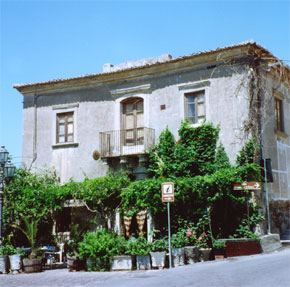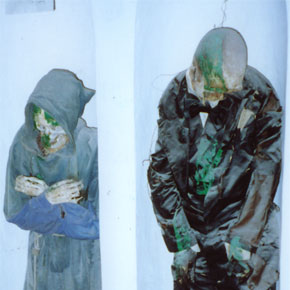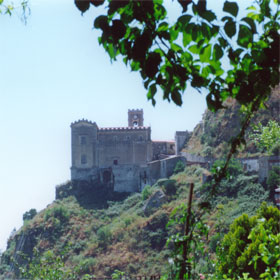Savoca, Sicily
An Eternal life - alla Siciliana
Baron Paolo Cacopardo stares at me horrifically through scorched eyes. Of late, he has lost some of his baronly portliness, his suntan could do with some serious beach-therapy and his suit needs a stitch and an iron. But considering the fellow’s been dead for a couple of centuries, he’s not in such bad shape.
Paolo Cacopardo and his aristocrat cronies are among the thirty or so mummified corpses to be found in the crypt of the Capuchin Monastery at Savoca. It’s one of the more gruesome sights to greet the visitor in Sicily but certainly one of the most impressionable.
This dusty crypt is no bigger than a billiard room and half of the goulish mummies confront you the moment you enter. Lined up in sculpted niches along the facing wall, they’re decked out in what would have been their Sunday best and seem to totter precariously towards you. A further horrific touch is that many of them have been daubed with green paint - apparently the work of local vandals who broke in one night in 1985. There’s an abbot encased in a glass box and a variety of other glass topped-and-sided coffins scattered around so haphazardly you could almost fall into them. Two babies in rough wooden boxes and a selection of skulls complete the eerie necropolis.Labels sellotaped to the wall above several of the corpses spare them from anonymity and, by way of scanty epitaph, inform us of their one-time trade: mostly doctors, lawyers, ecclesiastics or aristocrats. According to the blurb at the entrance there is even a poet among them - but I couldn’t find him. Perhaps his label had fallen off.
Mummification was evidently, therefore, an option only for the rich. Coming from the Persian word ‘mum’ meaning ‘wax’, however, the term perhaps implies greater scientific miracles than the ones used here at Savoca. The bodies were simply eviscerated and washed with vinegar and salt before being left to dry naturally on the slab of white marble or colatoio still visible in the crypt floor. The hole in the middle was to drain the various juices as they oozed from the body. Thoroughly desiccated, the body was again washed with vinegar, dressed in its best togs and propped up in its allotted niche.
But if the sight of these horrors is too much, ascend the steps out of the crypt to find Paradiso.
From the terrace of the Capuchin monastery, the view extends as far as Etna smouldering away in the distance beyond the hillside villages of Mongiuffi and Lìmina. I spent a good fifteen minutes just gazing at the unspoilt beauty of it. From here one gets a good vista too of the rest of Savoca, or rather, its few houses clinging to the bluff of rock topped by the ruins of its Saracen castle rising above the Ionian sea beyond. The hillside is studded with prickly pears - edible incidentally, though you’d need the Sicilians’ cunning tool to pick them off their forbidding cactus. In the past, these terraced slopes would have been intensively cultivated but their present abandonment is a sign sadly repeated throughout much of rural Sicily. I did spy beehives though, and if you were to come across the bee-keeper on your visit, he’d doubtless be only too happy to sell you some of his honey.
Apart from the catacombs, the other essential reason for coming to Savoca is a visit to the Bar Vitelli. It was here that Coppola shot the scene of Michael Corleone’s betrothal to Apollonia for his film “The Godfather” and nothing seems to have changed much since. This eighteenth Century stone building at the village entrance exhibits a charming atmosphere of run-downness that makes this one of the most scenic bars in all Sicily.
On the premise that in Italy one pays more to sit outside to drink your coffee, I passed beneath the pergola of vine leaves to head inside. The wood-panelled entrance was festooned with old black and white photos of Savoca and indecipherable sayings in Sicilian dialect. The bar was tucked away in an inconspicuous room to the left where I ordered a granita from an ancient Signora with a welcoming smile and a face like a walnut. I paid with a five thousand lire note and the Signora took down a tin of notes from a shelf to hand me my change. Her improvised safe was a rare spectacle. Money in Sicily, unless laundered into an armour plated Mercedes, is usually kept well out of sight. The Signora told us we could go and sit where we wished - there was no extra charge for sitting outside. Incidentally, coffee, I noticed, was the price it was in Rome five years ago.
An icy slush-drink similar to a sorbet and coming in various flavours, the granita is a Sicilian speciality, but nowhere is it better made than here. In the past it was made from the snow collected from the slopes of Etna. Here they go one better: it is home-made, with lemons picked off the trees in the village. And as a bonus, it comes with a zuccherata, a kind of sweet bread rather like a biscuit - and quite delicious.
I fell into easy conversation with the Signora, who I warmed to immediately. She is something of an expert on local matters and we talked about the Godfather films. “Talking of films,” she told me, “you’ve just missed Al Pacino’s doctor. He was in here drinking his coffee until five minutes ago.” I recalled the top of the range Mercedes, parked alla Siciliana in the middle of the road as we had driven into the village.
The other compulsory reason for visiting Savoca is to take the opportunity for a laconic stroll among some of the most beautiful scenery you will find in Sicily. There is only one street which loops round the tuft of rock and takes in all the sights: the square-towered, thirteenth century Chiesa Madre, the chiesa San Michele, the Saracen castle up a flight of steps - and don’t miss the beautifully restored fifteenth century window beside the Chiesa Madre. If you’re coming by car, it is possible to drive round, but there’s nowhere to park and, in anything larger than a Fiat Panda, you are risking your paint.
All of which suggests it is better to stroll. During the daytime Savoca is almost deserted and you’ll have the village to yourself. There are no shops but the village is all the better for it and if you’re coming from Taormina you’ll be frankly thankful. I took the fork to the left and walked anti-clockwise. Lean over the balustrade at just about any part and you will look into someone’s garden of fig trees, medlars, mulberries, almonds: a veritable and tempting fruit-basket if it weren’t for the knowledge that the padrone is almost certainly watching you...



